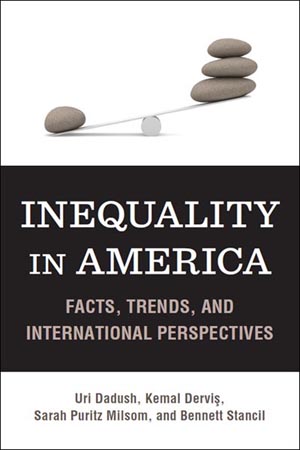Two pressing issues weighing on leaders at this week’s G-20 Summit in Hamburg, Germany, will be slowing productivity and rising inequality. Together, they produce weaker and less inclusive growth in incomes and living standards, and also contribute to societal woes and political divisiveness. In most major economies, productivity growth has slowed and income inequality has risen over the past one to two decades. These trends have been particularly marked and protracted in advanced economies.
In the United States, for example, total factor productivity in the first half of this decade averaged less than half the growth rate of the mid- to late-1990s. Over roughly the same period, income inequality, as measured by the broadest measure of inequality (the Gini coefficient), increased by close to 15 percent. Inequality at the top rose by much more. The income share of the richest 1 percent has more than doubled since the early 1980s, to around 22 percent, with more than half of that increase occurring since the mid-1990s.
Productivity and inequality trends have long been analyzed in isolation. More recently, however, experts have explored possible linkages between them. Recent work at the OECD and at the Brookings Institution (under an ongoing joint project with the Chumir Foundation) finds that the slowdown in productivity growth and the rise in inequality are interconnected, with important common drivers.
Much of the slowdown in productivity reflects an increased divergence in productivity between firms. Innovation and productivity growth have remained relatively robust in leading firms, but have slowed considerably in the vast majority of other, typically smaller firms. The benefits of the new technologies have been captured for the most part by a small number of firms. Aggregate productivity growth is lower in industries with wider inter-firm divergence in productivity. Barriers to a broader diffusion of the new technologies across firms are producing outcomes that are both inefficient and unequal.
Market concentration has increased and the distribution of profits has become much more unequal in most industries in advanced economies, especially in the United States. Part of this reflects the nature of some of the new technologies that, together with globalized markets, can produce “winner-takes-most” outcomes. Digital technologies in particular have network effects that encourage the rise of superstar firms, such as Facebook and Google. But a broader erosion of competition is also at play. In industries with less competition, productivity gaps between firms are wider and overall productivity growth is slower. Business dynamism, as measured by new firm formations, has declined
Barriers to competition have resulted in increased economic rents and reduced incentives to innovate and make new productivity-enhancing investment. They have also prevented the fruits of technological progress from being shared more broadly. Inefficient and unequal outcomes resulting from decreased competition in product markets were compounded by resource misallocations and rents associated with rapid financialization.
A similar interplay between slowing productivity and rising income inequality is seen in labor markets. Increased inequalities in firm productivity are mirrored by increased inequalities in labor incomes. As productivity and profitability gaps widened between firms, so did wage gaps. Industries experiencing higher market concentration, and earning higher rents, saw larger drops in labor’s share of income.
Digital technologies and automation have shifted demand toward new, higher-level technical and managerial skills. In advanced economies, globalization has exerted pressure in the same direction. The supply of skills, however, has been slow to respond. Education and training have been losing the race with technology.
The shortfall in the supply of skills relative to changing demand hindered the broader adoption of new technologies that require higher-level skills as complements, limiting productivity gains. Skilled workers increasingly were clustered in a small number of dominant firms. The relative scarcity of higher-level skills sharply increased skill premia and wage differentials, contributing to higher inequality. Again, these trends have been especially acute in the United States.
Productivity and equity are often seen in terms of a trade-off in economic debates. Recent research points to important complementarities between the two. Both slowing productivity and rising inequality are cause for major concern. But the good news is that, to the extent both are driven by common factors, there is scope for win-win policies.
One area is reforming technology policies. Policies that promote a broader diffusion of technological innovations and improve the productivity of lagging firms would both boost aggregate productivity growth and reduce inequality in labor incomes and returns to capital. Intellectual property regimes need to be better balanced so that they reward innovation, but also foster wider economic impacts. The patent system should be reviewed. Public investment in research and development has declined in many countries; it must recover.
A second area is boosting competition. In addition to eliminating regulations that restrict competition, this requires promoting competition through rulemaking and regulations where needed. The digital economy and globalization create new challenges in addressing concentration of market power, which will require innovation in competition and antitrust policies and in regulatory and tax frameworks covering cross-border business practices. Regulatory reform also needs to catch up with change in financial markets.
A third area is investing in skills. Education and training programs need to be strengthened and revamped to meet the increased demand for higher-level skills required by the new technologies, retrain workers whose skills are no longer needed, and address persistent inequalities in skill attainment. Again, the changing environment will call for innovation—in education, retraining and apprenticeship programs and in public-private partnerships. Social protection programs will need to adapt to support greater mobility of workers between jobs. Sensible policies on migration can complement national efforts in augmenting needed skills.
Much of recent political discourse has been focused on international trade as the culprit in causing job and earnings losses for less skilled workers and increasing inequality. But research shows that the dominant factor has been the nature of technological change and how it has interacted with policies affecting competition in markets, skill development, and labor mobility.
The political economy of reform is difficult. But, fortunately, the policy options are not limited to a binary choice between productivity and equity. There are policies that can promote both. Call it an agenda for productive equity. Politicians, notably leaders gathering in Hamburg for the G-20 Summit, should pay more attention to it.
The Brookings Institution is committed to quality, independence, and impact.
We are supported by a diverse array of funders. In line with our values and policies, each Brookings publication represents the sole views of its author(s).








Commentary
Productive equity and why it matters to the G-20
July 3, 2017